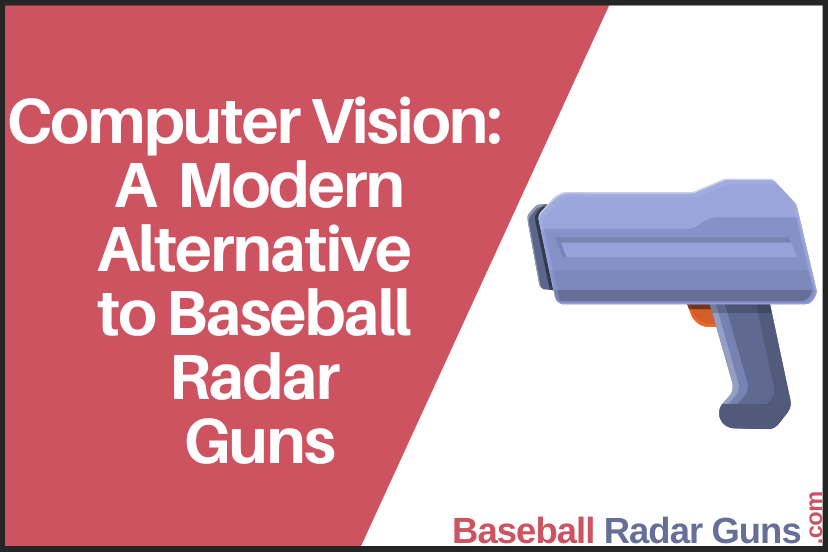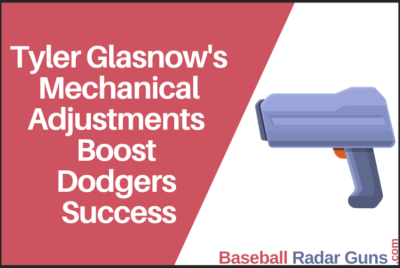The Rise of Computer Vision: A Modern Alternative to Baseball Radar Guns
*We may earn a commission for purchases made using our links. Please see our disclosure to learn more.
Computer vision technology holds promise in sports analytics. With modern cameras and powerful software, this technology now offers an alternative way to measure the speed of pitched baseballs. Traditional baseball radar guns use electromagnetic waves to calculate speeds, while computer vision uses digital images and smart algorithms to produce similar data. I have observed how these advancements can enrich how we understand and analyze baseball performance. In this article, I share my insights on how computer vision stands as a compelling alternative to traditional radar guns.
Table of Contents
Understanding Computer Vision Technology in Baseball
Computer vision involves capturing and processing images with algorithms that interpret speed and movement. In baseball, this technology can track the flight of a baseball from the pitcher’s to the rat-catcher’s. The method uses high-speed cameras placed in fixed positions around a field. The software then analyzes the images to calculate speed using frame-by-frame analysis. I have seen systems that provide reliable data without the need for bulky equipment, making it easier to set up on a baseball field. Advances in computing power have made these systems more accessible, paving the way for detailed performance tracking.
This technology has grown in use due to improvements in digital processing. Compared to radar guns, computer vision systems offer detailed insights, including the trajectory and spin of a baseball. The richness of the data means coaches and analysts can review every detail of a pitch. Often, teams combine these systems with other performance metrics, providing an all-in-one picture of a player’s performance. As I observe these trends, the importance of optical tracking systems becomes clear for training and game scenarios.
How Computer Vision Measures Ball Speed
Measuring the speed of a baseball using computer vision involves several steps. First, a camera captures high-definition video of the ball in motion. The video is then divided into individual frames. Each frame is analyzed by an algorithm that estimates the ball’s position. By comparing positions over a set number of frames, the system calculates the ball’s speed. I appreciate that this technology can work regardless of weather or the variability of radar signals.
The process starts with calibration. Cameras must be aligned correctly to cover the relevant area without distortion. Calibration ensures that each pixel accurately represents a part of the playing field. Once the system is calibrated, the software can adjust for lighting conditions and background changes. I have noted that even minor improvements in camera calibration can lead to more precise speed measurements. This ongoing refinement paves the way for computer vision systems to rival or even exceed the precision of traditional radar devices.
Another benefit is the ability to review multiple angles. Unlike radar guns that capture speed from one point, computer vision systems can combine data from various cameras. This multi-angle approach helps correct any errors and produces a more reliable final measurement. The result is an all-in-one analysis that considers every facet of the ball’s height. Reviewing the ball from several perspectives offers additional opportunities to verify the accuracy of each measurement.
Getting Started with Computer Vision Systems
Before deploying computer vision systems in a baseball setting, several preparatory steps must be taken. It is important to understand the basic elements required for setup and performance. I always stress the importance of a sound camera system since the quality of images directly affects measurement accuracy.
For those new to this approach, here are some practical steps that helped me when I first encountered computer vision technology:
- Select Appropriate Cameras: Choose high-speed cameras that can capture detailed images quickly. Cameras with high frame rates capture every moment of a pitch, ensuring no detail is missed.
- Calibrate Your System: Set up the cameras to cover the entire area where the ball is in play. Calibration ensures that measurements are accurate and that differences in angles or distances are correctly accounted for.
- Introduce Baseline Pitches: Start with pitches of known speeds to verify that the system produces reliable data. This helps fine-tune algorithms and ensure consistency.
- Utilize Consistent Lighting: Proper lighting is essential for clear images. Make sure the field is evenly lit to avoid shadows or bright spots that might alter the measurement.
- Integrate into Existing Analysis: Use the system data alongside other performance metrics. Many teams find that computer vision data complements radar readings, offering a fuller picture of a player’s performance.
These steps have often made a difference when I was comparing traditional methods with computer vision approaches. They create an environment where the technology can effectively deliver accurate, real-time feedback while remaining simple to operate, even for beginners.
Important Considerations for Integrating Computer Vision
Switching to computer vision as an alternative to radar guns involves a few important factors. I find it helpful to examine different aspects of the system before making any investment. Keeping an eye out for issues such as lighting variability and calibration errors can guide better integration and help avoid unexpected challenges.
- Lighting Conditions: Variable lighting can affect the quality of the images. Consistent illumination is very important for ensuring that the algorithms capture clear and correct data.
- Environmental Factors: Weather conditions, such as heavy rain or fog, can interfere with image capture. Adjustable settings that can accommodate various weather patterns are wise.
- Camera Resolution and Frame Rate: The higher the resolution and frame rate, the more detailed the analysis. However, higher quality often comes at a more significant cost. Balancing cost versus benefit is significant in these decisions.
- Data Processing Speed: Computer vision systems require quick processing times. I always check an algorithm’s response speed when selecting a system, especially if real-time analysis is needed.
Sensor Resolution
High sensor resolution plays a key role in capturing the details of a fast-moving baseball. Lower resolution may result in blurred images, leading to inaccurate speed calculations. I have observed that investing in cameras with better resolution often results in more reliable performance data. This ensures that even subtle movements are documented and accurately measured.
Lighting Conditions
Lighting is another key factor. Uneven or poor lighting can create shadows or glare that confuse the tracking software. Good lighting conditions contribute directly to the accuracy of computer vision systems. When setting up, I ensure that the field is evenly lit to minimize these issues and provide a clear view of each pitch.
Algorithm Processing
The software that interprets the images is central to the system’s performance. Algorithms must quickly and accurately identify the ball under varying conditions. I have found that well-tested software often produces consistent results across a range of scenarios. Running trial tests with various algorithms before finalizing any setup can help determine the best fit.
System Calibration
Calibration of both cameras and software cannot be overlooked. Any misalignment can lead to errors in measurement. I value systems that offer simple calibration tools which adjust for changes over the course of a game or practice session. Paying close attention to calibration makes the technology more dependable over time.
Reminding myself of these considerations ensures that the integration of computer vision into baseball measurements is as smooth as possible. Addressing these factors early in the process helps avoid many common pitfalls.
Advanced Techniques and Tips
Once you are comfortable with the basics of computer vision in baseball, you might want to explore ways to step up the system. I have found that there are many advanced approaches to boost accuracy and integrate analytics in a super detailed manner. These advanced tips can help turn basic data into actionable insights that both coaches and players can use to improve performance.
Step up Image Processing: Upgrading software to include machine learning can improve the system’s ability to recognize fast, blurry images. A machine learning model can learn from past errors and become better at handling unusual pitches, making the process smarter over time.
Integrate Multi-Camera Angles: Using two or three cameras can help verify measurements from different perspectives. Combining data from multiple angles refines results, especially when the ballball’sght deviates unexpectedly. This method offers additional checks that are crucial during complex plays.
Make the most of Post-Processing Techniques: Advanced analytics software can refine data after the game is over. I appreciate how additional post-processing can draw out trends over time, such as how a particular pitcher performs under various conditions. This extra layer of analysis helps teams make educated decisions regarding training and strategy.
These techniques not only help achieve more accurate measurements but also provide a richer data set for coaches and players. The extra steps allow teams to train better and make informed decisions during games.
The Basics: Why Beginners Should Consider Computer Vision
For those new to sports analytics, computer vision offers several practical benefits compared to traditional radar guns. I see computer vision as a versatile tool for both training and game-day analysis. It builds on familiar technology, making it accessible to newcomers who are willing to learn and experiment with new methods.
Some clear benefits include:
- Cost Considerations: Over time, computer vision systems can often cost less than high-end radar guns. Many teams find this cost-effectiveness appealing, particularly for regular practice sessions or youth leagues.
- All-in-One Data: Computer vision not only measures speed but can also track the trajectory and spin of a baseball. This additional data can help provide insights into pitching techniques and overall strategy, giving coaches a broader view of performance.
- Ease of Integration: Many modern sports analysis platforms work smoothly with computer vision data. I have seen systems where data from cameras is automatically uploaded to a team management system, making analysis simpler and more efficient.
These basic advantages help beginners enter the world of sports analytics without a steep learning curve or enormous initial investment. The flexibility of computer vision systems provides a way to start small and scale up as needed.
Frequently Asked Questions
Below are some questions I have encountered, along with my responses based on experience with computer vision systems in baseball:
Question: How accurate is computer vision compared to radar guns?
Answer: In controlled settings, computer vision can match or even exceed the accuracy of traditional radar guns. Accuracy depends on factors like camera quality, calibration, and environmental conditions.
Question: What is required to implement this technology?
Answer: Implementing computer vision systems typically requires high-speed cameras, reliable software, and proper calibration. You also need to ensure consistent lighting and clear camera positioning to obtain accurate results.
Question: Can computer vision data be integrated with other analytics?
Answer: Yes, many computer vision systems offer data formats that easily work with other sports analytics platforms. This compatibility allows teams to combine multiple data sources and gain an all-in-one picture of performance.
Final Thoughts
Computer vision technology is reshaping how baseball performance is analyzed. It offers a modern alternative to traditional radar guns by providing detailed, multi-dimensional data on every pitch. I have seen firsthand how this approach can benefit teams through more in-depth analysis. With improved accuracy, reduced equipment costs, and ease of integration, computer vision systems stand out as a viable option for both professional leagues and amateur teams.
Exploring and adopting these new technologies can lead to better coaching decisions and a deeper understanding of the game. I believe that with continual advancements in both hardware and software, the benefits of computer vision in baseball will only grow over time. Embracing this technology can give teams a competitive edge on the field and in training sessions. As I continue to follow its developments, I recommend considering computer vision as part of any modern sports analytics toolkit.
Future Prospects in Computer Vision Analytics
The road ahead for computer vision in sports is very exciting. Researchers are continuously testing new algorithms that can process images even faster and with greater accuracy. I have noticed that insights drawn from these systems are gradually expanding beyond just speed measurements. There is growing interest in predicting pitch outcomes and even assessing player biomechanics in real time. Such advancements may soon make it possible to monitor every aspect of a player’s performance using just video footage.
Furthermore, collaborations between tech companies and sports organizations promise to make these systems more affordable and accessible. As the technology matures, we can expect improvements in hardware that further simplify installation and calibration. This evolution may also include better integration with wearable devices, offering a multi-layered insight into game-day performance. I am eager to see how these developments unfold, as they have the potential to revolutionize not only baseball but many other sports.
The future of sports analytics is undoubtedly intertwined with technological innovation. With continuous improvements, computer vision systems will likely become the norm in professional training environments, while also being adapted for amateur and youth sports. This emerging trend is set to change how we think about data collection and performance evaluation. Every new update brings us one step closer to a fully immersive and highly detailed sports analytics experience.
This detailed exploration should give readers a sense of where the field is headed and how computer vision technology can reshape our understanding of athletic performance. By keeping up with these advancements and staying open to innovative approaches, teams and coaches can remain ahead of the curve in an increasingly competitive sports environment.




